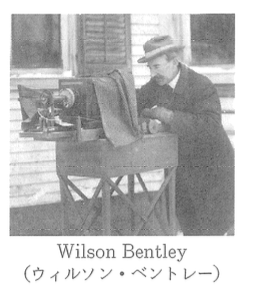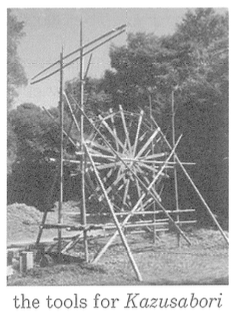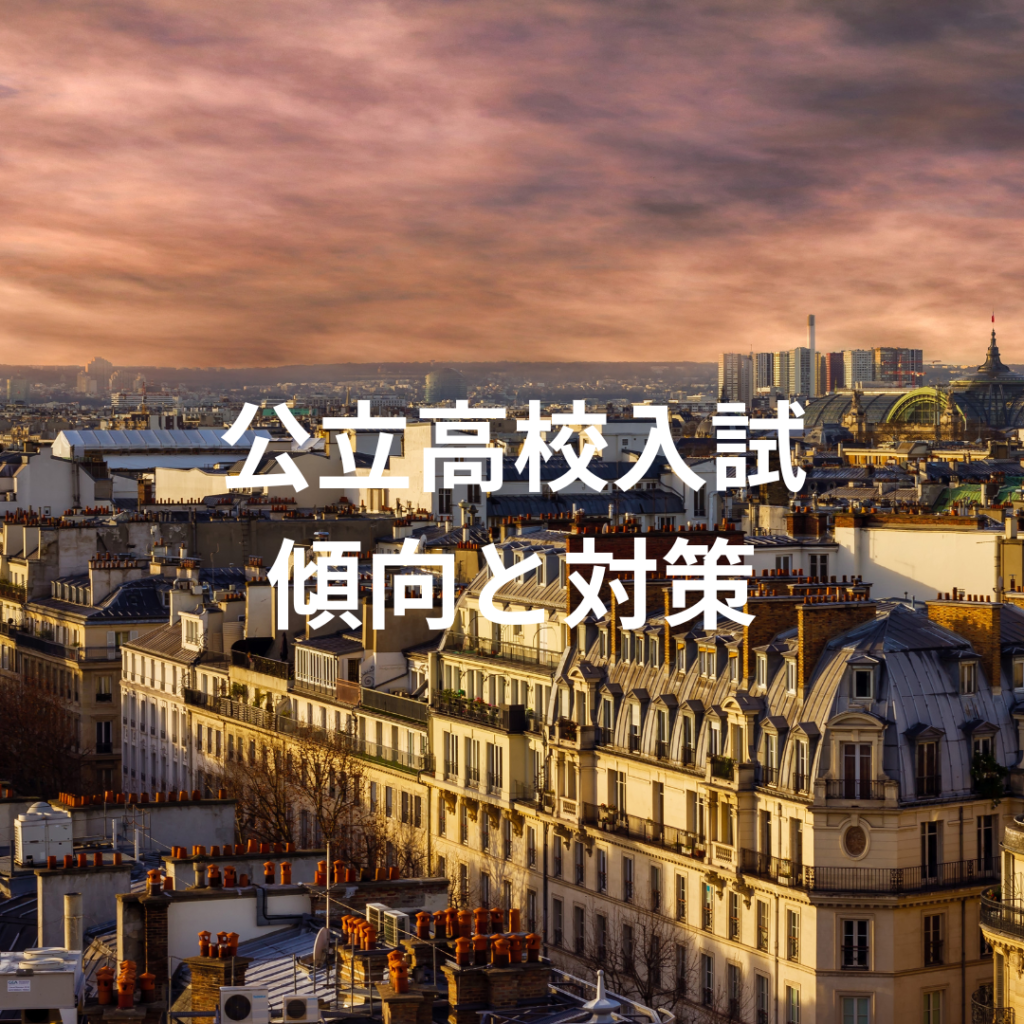最後に、傾向と対策・高校入試のしくみなどへのLINKがあります。
【1】
. 次は、高校生のリコ(Riko)、アメリカからの留学生のエマ(Emma)、クラスメートのタケオ(Takeo)の3人が学校で交わした会話の一部です。会話文を読んで、あとの問いに答えなさい。
Riko: Hi, Emma. What are you doing with your tablet?
Emma: Hi, Riko. I’m looking ( ① ) some photos of snow crystals. They are
beautiful, right?
Riko: Oh, yes, they are.
Takeo: Hi, Emma and Riko. What are you doing?
Riko: Hi, Takeo. Emma is showing me some photos of snow crystals on her tablet.

Takeo: Oh, they look beautiful.
Emma:These photos were actually taken about 100 years ago.
Takeo: That’s a long time ago. I didn’t know people could take such clear photos of snow crystals then.
Emma:An American man, Wilson Bentley, was able to take those photos after trying for a few years.( ② )
Takeo:No. I don’t know about him.
Riko: I don’t know about him, either. Can you tell us about him?

Emma:Sure. I read some books about the man before. According to Athem, he got interested in snow crystals when he was 15 years old. He lived in a village which had a lot of snow in winter. On his 15th birthday, he got an old microscope from his family. With that microscope, he saw snow crystals.
Takeo: I think it was hard to see them with a microscope. Snow disappears quickly in a warm room.
Emma:You’re right. To see the snow crystals, he often used his microscope outside his house. He didn’t mind staying outside in winter.
Riko: Wow, he was really interested in snow crystals.
Emma: By seeing many snow crystals with his microscope, he found no snow crystals had the same shape. He was excited to find that.
Takeo:Oh, I was also excited to find ( ③ ). I’m glad that he and I felt excited about the same point about snow crystals.
Emma:That’s good, Takeo.【ア】Later in his life, he expressed how he felt when he saw the various shapes of snow crystals.【イ】 He said that every snow crystal was a masterpiece of design.
Riko: Oh, I like the phrase he used.
Emma: He ( ④ ) how beautiful shapes of snow crystals were.
Takeo: So, did he decide to take photos of snow crystals?
Emma: Yes, but, to take photos of very small things like snow crystals, he had some difficult things to do.【ウ】 First, he had to connect a camera to his microscope. Also, in those days, he could only get a camera without high technology.【エ】He tried many ideas such as changing some parts of the camera.
Riko: Sounds hard.
Emma: After trying for a few years, he could finally take clear photos of snow crystals.
Riko: That means ( ⑤ )I can imagine how happy he was when he took the clear photo of a snow crystal for the first time.
Emma: I agree. Through his life, he took more than 5,000 photos of snow crystals. His photo book on snow crystals was first printed in 1931 and was sold in many stores.
Takeo:( ⑥ )
Emma:Yes.Actually, the photo book had an influence on a Japanese scientist. The scientist was moved by the photo book and he started his research on snow crystals. He studied how the shapes of snow crystals were made. His research is famous around the world.
Riko:Wow, it is interesting to know how one person’s works affected the life of someone else. I want to see more photos taken by Wilson Bentley. Thank you for telling us about him, Emma.
Takeo:After hearing your story about him, I want to know more about snow crystals. Thank you, Emma.
Emma: You’re welcome!
〔注〕microscope 顯微鏡 masterpiece 傑作
(1) 次のうち、( ① )に入れるのに最も適しているものはどれですか。一つ選びなさい。
ア at イ during ウ off エ since
正解:●●●
(2) 本文の内容から考えて、次のうち、本文中の( ② )に入れるのに最も適しているものはどれですか。一つ選びなさい。
ア Did you see the photos of snow crystals on my tablet?
イ Do snow crystals in his photos look beautiful?
ウ Have you heard about him?
エ How many times did he try?
正解:●●●
(3) 本文中のAthemの表している内容に当たるものとして最も適しているひとつづきの英語5語を、本文中から抜き出して書きなさい。
正解:●●●
(4) 本文の内容から考えて、次のうち、本文中の( ③ )に入れるのに最も適しているものはどれですか。一つ選びなさい。
ア all the shapes of snow crystals looked the same in the photos
イ each snow crystal had a different shape
ウ shapes of snow crystals could be seen in a warm room
エ special microscopes were made to see snow crystals
正解:●●●
(5) 本文中には次の英文が入ります。本文中のア~工から、入る場所として最も適しているものを一つ選びなさい。
So, he had to find a way to take clear photos of snow crystals with such a camera.
正解:●●●
(6) 本文中の“「He ( ④ )how beautiful shapes of snow crystals were.”が、「彼は雪の結晶の形がどれほど美しいかを人々に知ってほしかった。」という内容になるように、解答欄の【 】に英語4語を書き入れ、英文を完成させなさい。
正解:He 【 ●●● 】how beautiful shapes of crystals were.
(7) 本文の内容から考えて、次のうち、本文中の( ⑤ )に入れるのに最も適しているものはどれですか。一つ選びなさい。
ア he didn’t use his microscope and his camera for a few years
イ he kept trying to take clear photos of snow crystals until he had success
ウ he kept hiding the clear photos of snow crystals after he took those photos
エ he found someone who could take photos for him after he stopped taking photos of snow crystals
正解:●●●
(8) 本文中の( ⑥ )が、「それは、人々に雪の結晶に興味をもつ機会を与えたと私は思います。」という内容になるように、次の〔 〕内の語を並べかえて解答欄の【 】に英語を書き入れ、英文を完成させなさい。
I guess that it 〔become chances gave people to〕 interested in snow crystals.
正解:I guess that it 【 ●●● 】interested in snow crystals.
(9) 次のうち、本文で述べられている内容と合うものはどれですか。二つ選びなさい。
ア When Takeo talked to Emma and Riko, Emma was trying to take photos of snow crystals.
イ Wilson Bentley saw snow crystals with a microscope he got from his family.
ウ To take clear photos of snow crystals, Wilson Bentley faced some difficult things.
エ Riko said one of the photos Wilson Bentley took was a masterpiece.
オ Wilson Bentley was encouraged by a Japanese scientist and kept taking photos of snow crystals.
正解:●●●
【2】
高校生のミホ(Miho)が英語の授業でスピーチを行いました。次の[Ⅰ]、[Ⅱ]に答えなさい。
[I]次は、ミホが行ったスピーチの原稿です。彼女が書いた原稿を読んで、あとの問いに答えなさい。
Last week, when I was doing research about water problems in the world, I found some interesting information. According to Ait, a traditional Japanese method for digging a well is now helping people in other countries. The method is called “Kazusabori.” Kazusabori was developed in the late 19th century in the Kazusa area. The method was ( ① ) to many other areas in Japan and was used in those areas until people started to use machines for digging wells. Why is it now helpful overseas?This question ( ② ) to learn more about Kazusabori.
First, I will explain what Kazusabori is. It is a method for digging a deep well safely. The method was developed while people in the Kazusa area were trying to solve their water problems. In the area, rivers were in low places and it was difficult for farmers to bring water from those rivers to their land in higher places. So, people in the area dug wells to get water which was under the ground. Each well had to be deep enough to ( ③ ) water under the ground. At first, people dug a well by working inside a hole. However, that way was dangerous. Also, they couldn’t dig a deep well in that way.( ④ )The long stick was made of bamboo and had an iron part at the bottom. As the hole became deeper, they made the stick longer. Another tool was created to move the long stick without using much power. They also created a tool which helped them carry broken pieces of rocks out of the hole. With these toöls, people could safely dig a well which was a few hundred meters deep. People used bamboo and other materials around them to make these tools. There were many bamboo forests in the area, and bamboo was light, strong and flexible. The method of digging a well with these tools was used in many areas in Japan. People in those areas started to call the method Kazusabori.
About one century later, Kazusabori was introduced in some areas in the world as a method for digging a well without using a machine. In those areas, some people had to walk for many hours to a river to get water and then walk back with heavy water. In 1981, people started to dig wells with Kazusabori in one Asian country. Wells ( ⑤ ) in some schools helpedchildren get water easily. Later, Kazusabori was introduced in one country in Africa, too. However, people there couldn’t get bamboo. So, people used the idea of Kazusabori and made similar tools for digging a well with things such as rubber tubes.( ⑥ ) Finally, they completed some wells by using their tools. The number of wells in Asia and Africa increased little by little, and now more people are able to get water easily. In the world, there are still serious water problems. I’m proud of Kazusabori because it helps people solve them.
Thank you for listening.

〔注〕
dig 掘る(過去形はdug)
well 井戸
Kazusabori 上総掘り(上総地方(現在の千葉県中央部)に伝わる井戸掘りの方式)
the Kazusa area 上総地方
safely 安全に
iron 鉄
flexible しなやかな
bamboo 竹
rubber tube ゴム管
(1) 本文中のAitの表している内容に当たるものとして最も適しているひとつづきの英語3語を、本文中から抜き出して書きなさい。
正解:●●●
(2) 本文の内容から考えて、次のうち、本文中の( ① )に入れるのに最も適しているものはどれですか。一つ選びなさい。
ア joined イ returned ウ spread エ worn
正解:●●●
(3) 本文中の“This question( ② ) to learn more about Kazusabori.”が、「この疑問が、上総掘りについてより多くのことを学ぼうと私に決心させました。」という内容になるように、解答欄の【 】に英語3語を書き入れ、英文を完成させなさい。
正解:This question ●●● to learn more about Kazusabori.
(4) 本文の内容から考えて、( ③ )に入れるのに最も適しているものはどれですか。次のうち、本文中の一つ選びなさい。
ア add イ change ウ leave エ reach
正解:●●●
(5) 本文中の( ④ )に、次の(i)~(ⅲ)の英文を適切な順序に並べかえ、前後と意味がつながる内容となるようにして入れたい。あとのア~エのうち、英文の順序として最も適しているものはどれですか。一つ選びなさい。
(i) By moving the long stick outside the hole, people could break rocks in the hole without working inside the hole.
(ii)One of them was a long stick used to make a deep hole.
(iii) So, people kept improving their way for digging a well, and finally created some useful tools.
ア (i) → (ⅱ) → (ⅲ)
イ (i) → (ⅲ) → (ⅱ)
ウ (ⅲ) → (i) → (ⅱ)
エ (ⅲ) → (ⅱ) → (i)
正解:●●●
(6) 次のうち、本文の( ⑤ )に入れるのに最も適しているものはどれですか。一つ選びなさい。
ア complete イ completed ウ were completed エ were completing
正解:●●●
(7) 本文中の( ⑥ )が、「彼らはそこで簡単に得ることができるものを使いました。」という内容になるように、次の〔 〕内の語を並べかえて解答欄の【 】に英語を書き入れ、英文を完成させなさい。
They 〔 could they things used 〕 easily get there.
正解:They ●●● easily get there.
(8) 次のうち、本文で述べられている内容と合うものはどれですか。一つ選びなさい。
ア Miho learned that Kazusabori was developed while people in the Kazusa area were making an effort to solve their water problems.
イ Miho learned that people in the Kazusa area easily brought water to their land in low places from rivers in higher places.
ウ Miho learned that people in the Kazusa area dug a well which was a few hundred meters deep without using any tools.
エ Miho learned that the number of wells in Asia and Africa decreased because people started to get water easily from rivers.
正解:●●●
(9) 本文の内容と合うように、次の問いに対する答えをそれぞれ英語で書きなさい。ただし、①は3語、②は8語の英語で書くこと。
① Did people in the Kazusa area use bamboo to make tools for digging a well?
② Why is Miho proud of Kazusabori?
正解:
① ●●●
② ●●●
[Ⅱ] スピーチの後に、あなた(You)とミホが、次のような会話をするとします。あなたならば、どのような話をしますか。あとの条件1・2にしたがって、(①)、(②)に入る内容をそれぞれ英語で書きなさい。解答の際には記入例にならって書くこと。文の数はいくつでもよい。
You:Miho, your speech was interesting. People have made various things to improve their lives.( ① )
Miho:I agree.What is the most convenient thing in your life? How is it convenient?
You:( ② )
Miho: I see.
<条件1> ①に、「今では私たちを助けてくれるものがたくさんあります。」と伝える文を、10語程度の英語で書くこと。
<条件2>②に、前後のやり取りに合う内容を、20語程度の英語で書くこと。

大阪府教育委員会のホームページより、最新の情報が得られます。必要に応じて、見るようにしましょう!






